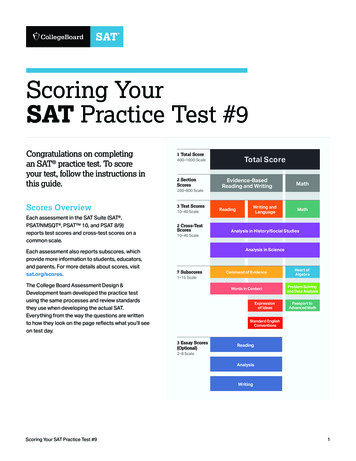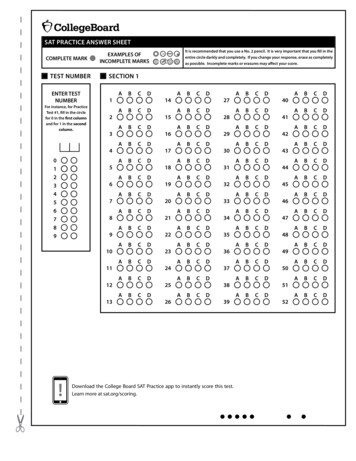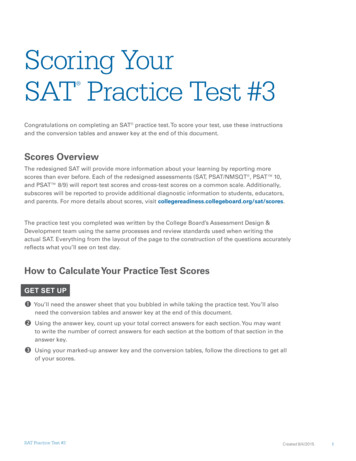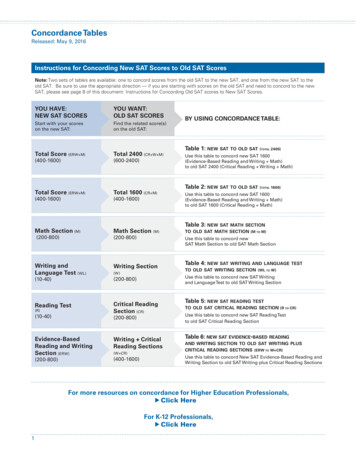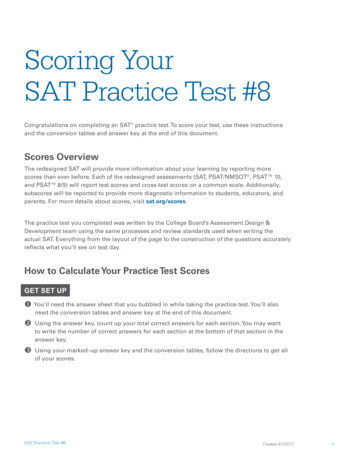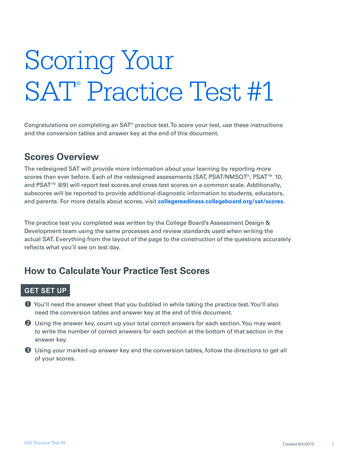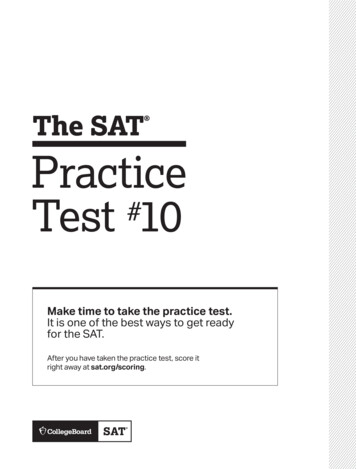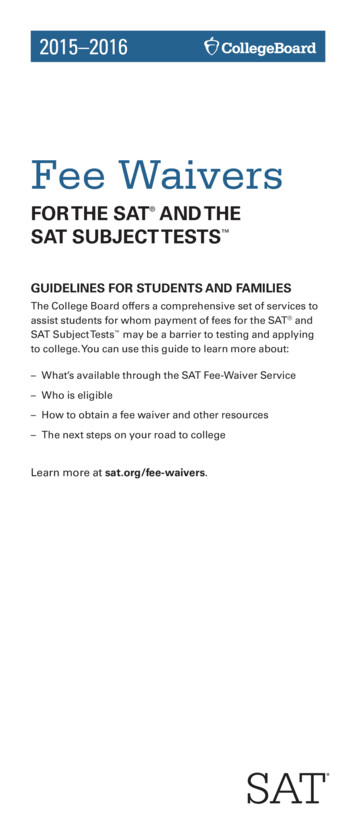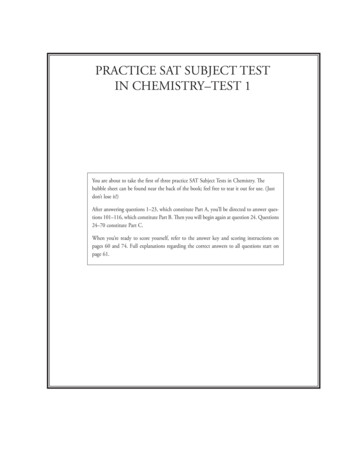
Transcription
PRACTICE SAT SUBJECT TESTIN CHEMISTRY–TEST 1You are about to take the first of three practice SAT Subject Tests in Chemistry. Thebubble sheet can be found near the back of the book; feel free to tear it out for use. (Justdon’t lose it!)After answering questions 1–23, which constitute Part A, you’ll be directed to answer questions 101–116, which constitute Part B. Then you will begin again at question 24. Questions24–70 constitute Part C.When you’re ready to score yourself, refer to the answer key and scoring instructions onpages 60 and 74. Full explanations regarding the correct answers to all questions start onpage 61.
SAT SUBJECT TEST IN CHEMISTRYRgDsPERIODIC TABLE OF THE ELEMENTSDO NOT DETACH FROM BOOK.MATERIAL IN THE FOLLOWING TABLE MAY BE USEFUL IN ANSWERING THEQUESTIONS IN THIS EXAMINATION.GO ON TO THE NEXT PAGEPractice Test 1 45
SAT SUBJECTTEST INTESTCHEMISTRY–TEST1—ContinuedSAT SUBJECTIN CHEMISTRY–TEST1Note: For all questions involving solutions and/or chemical equations, assume that the system is in purewater unless otherwise stated.Part ADirections: Each set of lettered choices below refers to the numbered statements or questions immediatelyfollowing it. Select the one lettered choice that best fits each statement or answers each question, and thenfill in the corresponding oval on the answer sheet. A choice may be used once, more than once, or not at allin each set.Questions 1-4 refer to the following.(A)(B)(C)(D)(E)ThermometerConductivity testerVolumetric flaskBuretGraduated cylinder1. May be used in combination with a calorimeter tocompare the specific heats of two substances2. Is used to measure the volume of a solid by waterdisplacement3. Useful for adding small quantities of acid into abaseQuestions 5-9 refer to the following.(A)(B)(C)(D)(E)Nucleic acidsProteinsCarbohydratesLipidsElectrolytes5. Always amphoteric in nature6. Found as both straight-chained and branchedpolymers7. Deoxyribose in DNA nucleotides belongs to thisfamily of biologically important molecules8. Always ionic in nature4. Is considered infinitely precise at a specificvolume9. Tend not to be water soluble, and aggregate intodroplets or molecular bilayersGO ON TO THE NEXT PAGE46 Cracking the SAT Subject Test in Chemistry
SAT SUBJECT TEST IN CHEMISTRY–TEST 1—ContinuedQuestions 10-13 refer to the following.Questions 14-16 refer to the following.(A) Ag Br – AgBr146(C)23492(D)3015U P Th 42 He230903014EnergyC 147 N -10 e(B)ASi 01 e(E) 2HgO 2Hg O210. Represents the decomposition of a compoundinto its constituent elements11. Represents alpha decay12. Represents an oxidation-reduction reactionECBDReaction Time14. Is the activation energy of the reverse reaction15. Is the enthalpy change of the forward reaction16. Represents energy of the activated complex13. Causes the neutron-to-proton ratio in a nucleus tobe loweredGO ON TO THE NEXT PAGEPractice Test 1 47
SAT SUBJECT TEST IN CHEMISTRY–TEST 1—ContinuedQuestions 17 -20 refer to the following.(A)(B)(C)(D)(E)Hydrogen bondingIonic bondingMetallic bondingNonpolar covalent bondingPolar covalent bondingQuestions 21-23 refer to the following.(A)(B)(C)(D)(E)Iron(III) chloride, FeCl3(s)Iodine, I2(s)Sodium hydroxide, NaOH(s)Sucrose, C12H22O11(s)Graphite, C(s)17. Holds a sample of barium iodide, BaI2, together21. Gives off a purplish vapor as it sublimes18. Allows solids to conduct electricity22. Can conduct electricity in the solid state19. Attracts atoms of hydrogen to each other in anH2 molecule23. Its dissolution in water is highly exothermic20. Responsible for relatively low vapor pressureof waterGO ON TO THE NEXT PAGE48 Cracking the SAT Subject Test in Chemistry
SAT SUBJECT TEST IN CHEMISTRY–TEST 1—ContinuedPLEASE GO TO THE SPECIAL SECTION LABELED CHEMISTRY AT THE LOWER RIGHTHAND CORNER OF THE ANSWER SHEET YOU ARE WORKING ON AND ANSWERQUESTIONS 101–116 ACCORDING TO THE FOLLOWING DIRECTIONS.Part BDirections: Each question below consists of two statements, I in the left-hand column and II in the right-handcolumn. For each question, determine whether statement I is true or false and whether statement II is true or false,and fill in the corresponding T or F ovals on your answer sheet. Fill in oval CE only if statement II is a correctexplanation of statement I.EXAMPLES:IIIEX 1. H2 SO4 is a strong acidBECAUSEH2 SO4 contains sulfur.EX 2. An atom of oxygen is electrically neutralBECAUSEan oxygen atom contains an equalnumber of protons and electrons.SAMPLE ANSWERSIIICEEX 1TFTFEX 2TFTFIII101.Carbon is a nonmetalBECAUSEcarbon atoms can bond with each other.102.Two isotopes of the same elementBECAUSEhave the same mass numberisotopes have the same number ofprotons.103.The density of a sample of waterBECAUSEis doubled by doubling its masscompared to a gas, the molecules in aliquid are relatively far apart.104.Sodium and cesium exhibit similarBECAUSEchemical propertiestheir atoms have the same number ofvalence electrons.105.An endothermic reaction can beBECAUSEspontaneousboth enthalpy and entropy changesaffect the value of a reaction’s Gibbsfree energy change.106.The 4s orbital fills before the 3dBECAUSEorbitalssubshells fill in order from lowerto higher energy.107.Calcium acts as a reducing agentBECAUSEwhen it reacts with brominemass is conserved in a chemicalreaction.GO ON TO THE NEXT PAGEPractice Test 1 49
SAT SUBJECT TEST IN CHEMISTRY–TEST 1—ContinuedIII108.If an acid is added to pure water, itBECAUSEadding an acid to water raises theincreases the water’s pHhydrogen ion concentration in thewater.109.Covalent bonds must be broken fora liquid to boilBECAUSEheat must be released for a liquid tochange into a gas.110.Alpha particles can be detectedusing a Geiger counterBECAUSEall radioactive elements are highlychemically reactive.111.As ice absorbs heat and begins tomelt, its temperature remainsconstantBECAUSEthe absorbed heat is consumed by thebreaking of intermolecular interactions.112.When a solute is added to purewater, the vapor pressure of thewater will decreaseBECAUSEall solutes dissociate into positive andnegative ions.113.The rate of a reaction is acceleratedby increasing temperatureBECAUSEa large equilibrium constant favors theformation of product.114.Hydrofluoric acid, HF(aq), is aweaker electrolyte thanhydrochloric acid, HCl(aq),BECAUSEfluorine has a lower electronegativitythan chlorine.115.A nonpolar molecule can have polarbondsBECAUSEpolar bonds can be symmetricallyarranged in a molecule so that there areno net poles.RETURN TO THE SECTION OF YOUR ANSWER SHEET YOU STARTED FOR CHEMISTRY ANDANSWER QUESTIONS 24–70.GO ON TO THE NEXT PAGE50 Cracking the SAT Subject Test in Chemistry
SAT SUBJECT TEST IN CHEMISTRY–TEST 1—ContinuedPart CDirections: Each of the questions or incomplete statements below is followed by five suggested answers orcompletions. Select the one that is best in each case and then fill in the corresponding oval on the answer sheet.24. What is the number of protons and neutrons in anatom with mass number 89 and atomic number 39 ?(A)(B)(C)(D)(E)50 protons and 50 neutrons50 protons and 39 neutrons39 protons and 89 neutrons39 protons and 50 neutrons39 protons and 39 neutrons. . . C4H10(g) . . . O2(g) . . . CO2(g) . . . H2O(l)25. When the above equation is balanced using thelowest whole-number terms, the coefficient ofCO2 is(A)(B)(C)(D)(E)248101326. Which of the following is closest in mass to aproton?(A)(B)(C)(D)(E)Alpha particlePositronNeutronElectronHydrogen molecule27. What is the approximate percentage compositionby mass of the element oxygen in the compoundHClO4 ?(A)(B)(C)(D)(E)16%32%50%64%75%28. If two atoms that differ in electronegativitycombine by chemical reaction and share electrons,the bond that joins them will be(A)(B)(C)(D)(E)metallicionica hydrogen bondnonpolar covalentpolar covalent29. When the temperature of a 20-gram sample ofwater is increased from 10 C to 30 C, the heattransferred to the water is(A) 600 calories(B) 400 calories(C) 200 calories(D) 30 calories(E) 20 calories30. What is the oxidation state of chromium, Cr, in thecompound potassium dichromate, K2Cr2O7 ?(A) 1(B) 2(C) 3(D) 6(E) 1231. An aqueous solution with pH 5 at 25 C has ahydroxide ion (OH –) concentration of(A)(B)(C)(D)(E)11111 10–11 molar10–9 molar10–7 molar10–5 molar10–3 molarGO ON TO THE NEXT PAGEPractice Test 1 51
SAT SUBJECT TEST IN CHEMISTRY–TEST 1—Continued2H2O(g) 2H2(g) O2(g)32. The volume of water vapor required to produce44.8 liters of oxygen by the above reaction is(A) 11.2 liters(B) 22.4 liters(C) 44.8 liters(D) 89.6 liters(E) 100.0 liters33. When 190 grams of MgCl2 are dissolved in waterand the resulting solution is 500 milliliters involume, what is the molar concentration of MgCl2in the solution?(A) 2.0 M(B) 4.0 M(C) 8.0 M(D) 12.0 M(E) 16.0 M34. When a fixed amount of gas has its Kelvintemperature doubled and its pressure doubled, thenew volume of the gas is(A)(B)(C)(D)(E)four times greater than its original volumetwice its original volumeunchangedone-half its original volumeone-fourth its original volume35. In 12.4 hours, a 100 gram sample of an elementdecays so that its mass is 25 grams. What isthe approximate half-life of this radioactivesubstance?(A) 1.6 hours(B) 3.1 hours(C) 6.2 hours(D) 24.8 hours(E) 49.6 hours36. In the equation Q 42 He represented by Q Bi21685At , the species37. A compound with a molecular weight of 56 amuhas an empirical formula of CH2. What is itsmolecular formula?(A)(B)(C)(D)(E)C2H2C2H4C4H8C4H10C6H1238. The change in heat energy for a reaction is bestexpressed as a change in(A)(B)(C)(D)(E)enthalpyabsolute temperaturespecific heatentropykinetic energy. . . NF3(g) . . . H2O(g) . . . HF(g) . . . NO(g) . . . NO2(g)39. When the equation for the reaction above isbalanced, how many moles of NF3 would berequired to react completely with 6 moles of H2O ?(A)(B)(C)(D)(E)0.5 mole1 mole2 moles3 moles4 molesGO ON TO THE NEXT PAGE52 Cracking the SAT Subject Test in Chemistry
SAT SUBJECT TEST IN CHEMISTRY–TEST 1—Continued40. Which characteristic is associated with bases?(A) React with metal to produce hydrogen gas(B) Donate an unshared electron pair(C) Always contain the hydroxide ion in theirstructure(D) Taste sour(E) Formed by the reaction of a nonmetal oxideand water41. An element has the following properties: shiny,brittle, poor electrical conductivity, and highmelting point. This element can be best classifiedas a(n)(A)(B)(C)(D)(E)alkali metalhalogenmetalloidtransition metalnoble gas42. Which of the following forward processesproduces a decrease in entropy?I. H2O(g) H2O(l)II. Fe2 (aq) S2 – (aq) FeS(s)III. 2SO3(g)2SO2(g) O2(g)(A)(B)(C)(D)(E)I onlyIII onlyI and II onlyII and III onlyI, II, and III43. Which of the following will raise the boiling pointof a sample of water?(A)(B)(C)(D)(E)Heat the waterMix gasoline into the waterBring the water sample to a higher altitudePlace the water sample on a magnetic stirrerDissolve table sugar into the water44. Elements H and J lie in the same period. If theatoms of H are smaller than the atoms of J, thencompared to atoms of J, atoms of H are mostlikely to(A)(B)(C)(D)(E)exist in a greater number of isotopesexist in a lesser number of isotopesexist in a greater number of oxidation stateshave a greater positive charge in their nucleihave a lesser positive charge in their nuclei. . . Al(s) . . . O2(g) . . . Al2O3(s)45. When the equation representing the reactionshown above is completed and balanced and allcoefficients are reduced to lowest whole-numberterms, the coefficient of O2(g) is(A)(B)(C)(D)(E)1234646. Which of the following solids has a brilliant 7. Twenty-five percent of element X exists as 210Xand 75 percent of it exists as 214X. What is theatomic weight of element X in amu?(A) 85(B) 211(C) 212(D) 213(E) 214GO ON TO THE NEXT PAGEPractice Test 1 53
SAT SUBJECT TEST IN CHEMISTRY–TEST 1—Continued48. A 600-milliliter container holds 2 moles of O2(g),3 moles of H2(g), and 1 mole of He(g). Totalpressure within the container is 760 torr. What isthe partial pressure of O2 ?(A)(B)(C)(D)(E)127 torr253 torr380 torr507 torr760 torrFe(OH)3(s)51. All of the following when added to water willproduce an electrolytic solution s)NH3 (aq) H2CO3(aq)–Fe3 (aq) 3OH (aq)49. The ionic solid Fe(OH)3 is added to water anddissociates into its component ions, as shownabove. The solubility product expression for thesaturated solution is(A) Ksp [Fe3 ] [OH –]–NH4 (aq) HCO3 (aq)52. In the reaction represented above, NH4 acts B) Ksp [Fe3 ] [3OH–](C) Ksp [Fe3 ] [3OH–]3(D) Ksp [Fe3 ] [OH–]3[Fe3 ] [OH–]3(E) Ksp [Fe(OH)3]50. Which of the following electron configurationsrepresents an atom of magnesium in an s22s22p53s23p21s22s22p63s13p11s22s22p63s13p2GO ON TO THE NEXT PAGE54 Cracking the SAT Subject Test in Chemistry
SAT SUBJECT TEST IN CHEMISTRY–TEST 1—Continued53. Which species has the ground state electronconfiguration 1s22s22p63s23p6 ?(A)(B)(C)(D)(E)Sulfide ion, S2–Bromide ion, Br –Neon atom, NeChromium ion, Cr3 Potassium atom, K54. Which of the following species is –455. An ideal gas has a volume of 10 liters at 20 C anda pressure of 750 mmHg. Which of the followingexpressions is needed to determine the volume ofthe same amount of gas at STP?(A) 10 750 0 L760 20(B) 10 750 293 L760 273(C) 10 760 0 L750 20(D) 10 760 273 L750 293(E) 10 750 273 L760 293GO ON TO THE NEXT PAGEPractice Test 1 55
SAT SUBJECT TEST IN CHEMISTRY–TEST 1—ContinuedQuestions 56-57 pertain to the phase diagram forsubstance Z below.2.5Pressure (atm)2.01.51.0SOLIDLIQUID100200300 400 500Temperature (K)60056. Substance Z is at 0.5 atm and 200 K. If thepressure on substance Z is steadily increasedand its temperature is kept constant, what phasechange will eventually blimationVaporization57. The normal boiling point of substance Z isclosest to(A)(B)(C)(D)(E)(A)(B)(C)(D)(E)benttrigonal pyramidallineartrigonal planartetrahedral59. What volume of 0.4 M Ba(OH)2 (aq) is needed toexactly neutralize 100 milliliters of 0.2 M HBr(aq) ?GAS0.558. The shape of a PCl3 molecule is described as100 K200 K300 K400 K500 K(A) 25 mL(B) 50 mL(C) 100 mL(D) 200 mL(E) 400 mL60. Which of the following is true regarding the–aqueous dissociation of HCN, Ka 4.9 10 10at 25 C ?–I. At equilibrium, [H ] [CN ]II. At equilibrium, [H ] [HCN]III. HCN(aq) is a strong acid.(A)(B)(C)(D)(E)I onlyII onlyI and II onlyII and III onlyI, II, and III61. Which of the following atoms has the largestsecond ionization energy?(A)(B)(C)(D)(E)Silicon, SiCalcium, CaChlorine, ClIron, FeSodium, NaGO ON TO THE NEXT PAGE56 Cracking the SAT Subject Test in Chemistry
SAT SUBJECT TEST IN CHEMISTRY–TEST 1—ContinuedQuestion 62 refers to the overall reaction and halfreactions with standard reduction potentials below.2H2O(l) 2H2(g) O2(g)ΔH 572 kJ/mol62. Given the enthalpy change for the above reaction,what would the enthalpy change forH2(g) ½O2(g) H2O(l) ?(A)(B)(C)(D)(E)– 286 kJ/mol 286 kJ/mol– 1044 kJ/mol 1044 kJ/mol 572 kJ/mol63. The reaction of zinc metal, Zn, and hydrochloricacid, HCl, produces which of the following?I. H2(g)II. Cl2(g)III. Zn2 (aq)(A)(B)(C)(D)(E)II onlyIII onlyI and II onlyI and III onlyI, II, and IIIQuestions 64-65 refer to the following reaction.2H2S(g) 3O2(g)2SO2(g) 2H2O(g) heat64. For the above reaction, the equilibriumconcentration of SO2(g) can be increased by(A)(B)(C)(D)(E)adding neon gasincreasing the temperatureadding a catalystincreasing the concentration of H2O(g)increasing the concentration of O2(g)65. Which of the following is increased bydecreasing the volume of the reaction system?I. Rate of reactionII. Equilibrium concentration of reactantsIII. Value of Keq(A)(B)(C)(D)(E)I onlyIII onlyI and II onlyII and III onlyI, II, and IIIFe2O3(s) 3CO(g) 2Fe(s) 3CO2(g)66. When 3 moles of Fe2O3 are allowed tocompletely react with 56 grams of CO accordingto the above equation, approximately how manymoles of iron, Fe, are produced?(A)(B)(C)(D)(E)0.71.32.02.76.0GO ON TO THE NEXT PAGEPractice Test 1 57
SAT SUBJECT TEST IN CHEMISTRY–TEST 1—ContinuedGlass TubingBeakerWaterNa 2O2 H 2O2Na2O2(s) 2H2O(l) 4NaOH(aq) O2(g)67. Sodium peroxide, Na2O2, and water react in theflask at 25 C according to the equation and in thediagram above. If water levels are equal inside andoutside the beaker, then the gas pressure inside thebeaker is equal to the(A) pressure of oxygen gas collected(B) vapor pressure of water at 25 C(C) sum of pressure of oxygen gas collected andatmospheric pressure(D) sum of vapor pressure of water at 25 C andatmospheric pressure(E) sum of pressure of oxygen gas collected andvapor pressure of water at 25 C68. Which of the following molecules has thestrongest carbon-to-carbon O2(g)The following concentration data were gatheredfor the above reaction at 5 minute intervals fromthe start of an experiment:Time After Startof Experiment[N2O4][NO2]0 min (start)5 min10 min15 min20 min25 min0.00 M0.10 M0.20 M0.25 M0.28 M0.28 M0.50 M0.33 M0.20 M0.15 M0.13 M0.13 M69. If the experiment was carried out in a closedsystem at constant temperature, then during whichtime interval (from the start of the experiment) didthe reaction most likely achieve equilibrium?(A)(B)(C)(D)(E)0 min (start) to 5 min5 min to 10 min10 min to 15 min15 min to 20 min20 min to 25 min70. The emission spectrum of an element can becreated when atoms of that element are(A) reacted with a different atom to form a newmolecule(B) fired from a machine into a patch of metalfoil(C) change phase(D) exposed to an outside energy source(E) cooled to extremely low temperaturesSTOPIf you finish before time is called, you may check your work on this section only.Do not turn to any other section in the test.58 Cracking the SAT Subject Test in Chemistry
PRACTICE SAT SUBJECT TEST IN CHEMISTRY–TEST 1 You are about to take the first of three practice SAT Subject Tests in Chemistry. The bubble sheet can be found near the back of the book; feel free to tear it out for use. (Just don’t lose it!) After answering questions 1–23, which constitute Part A, you’ll be directed to answer ques-

